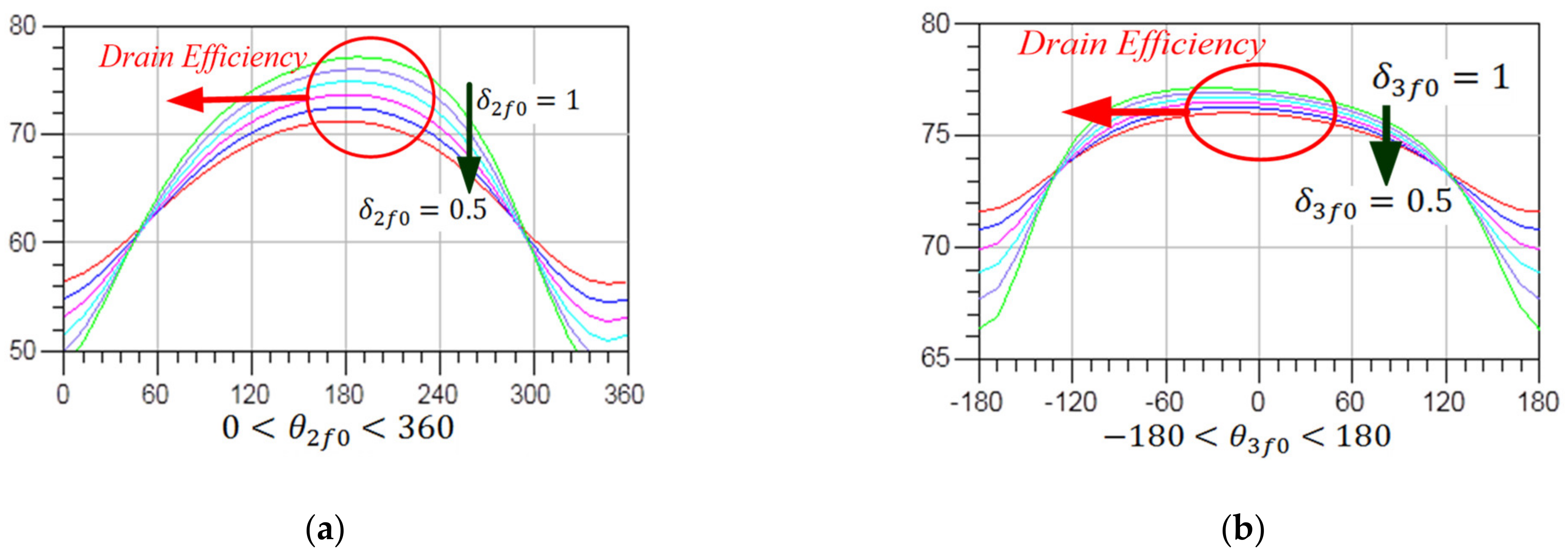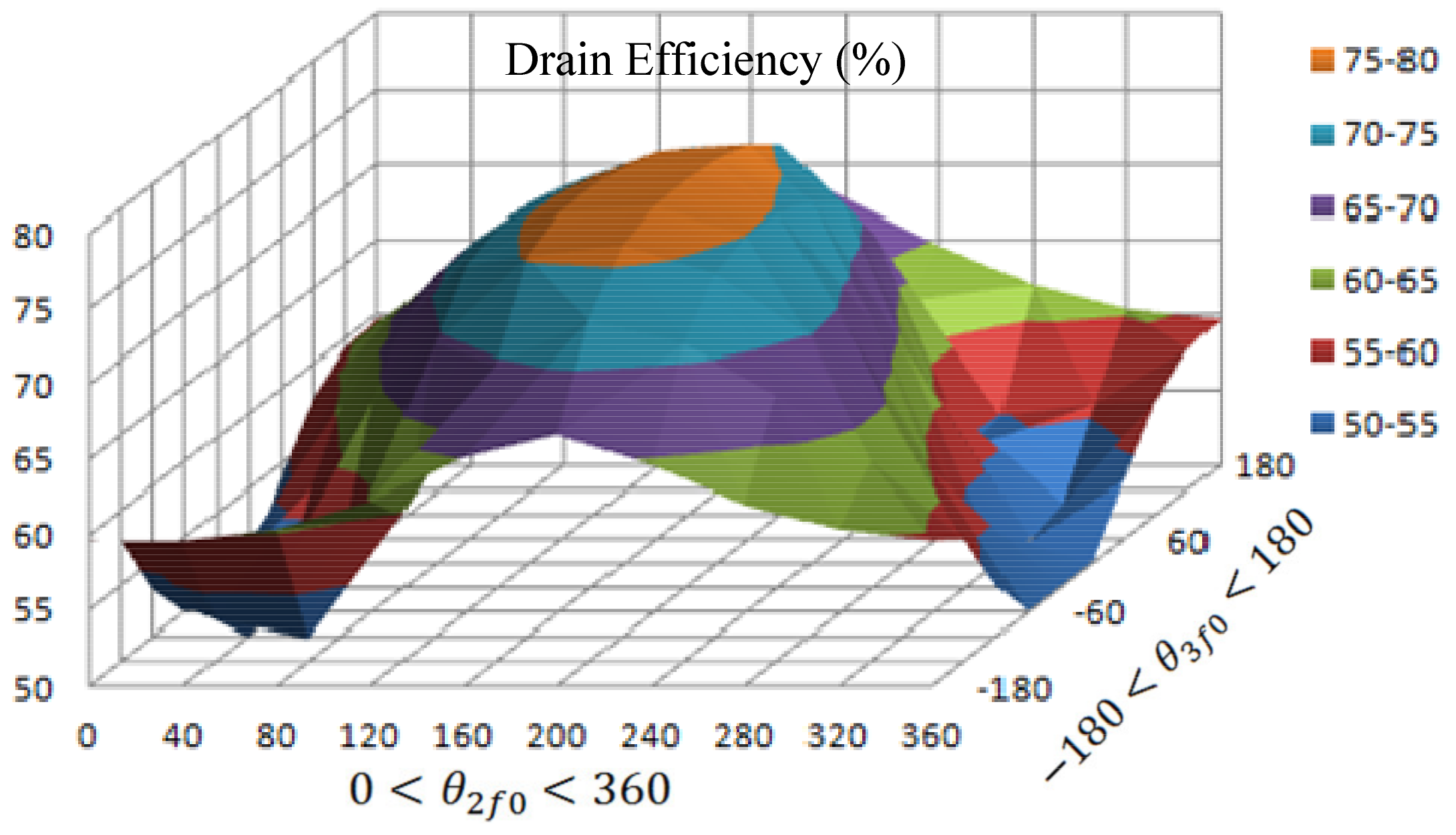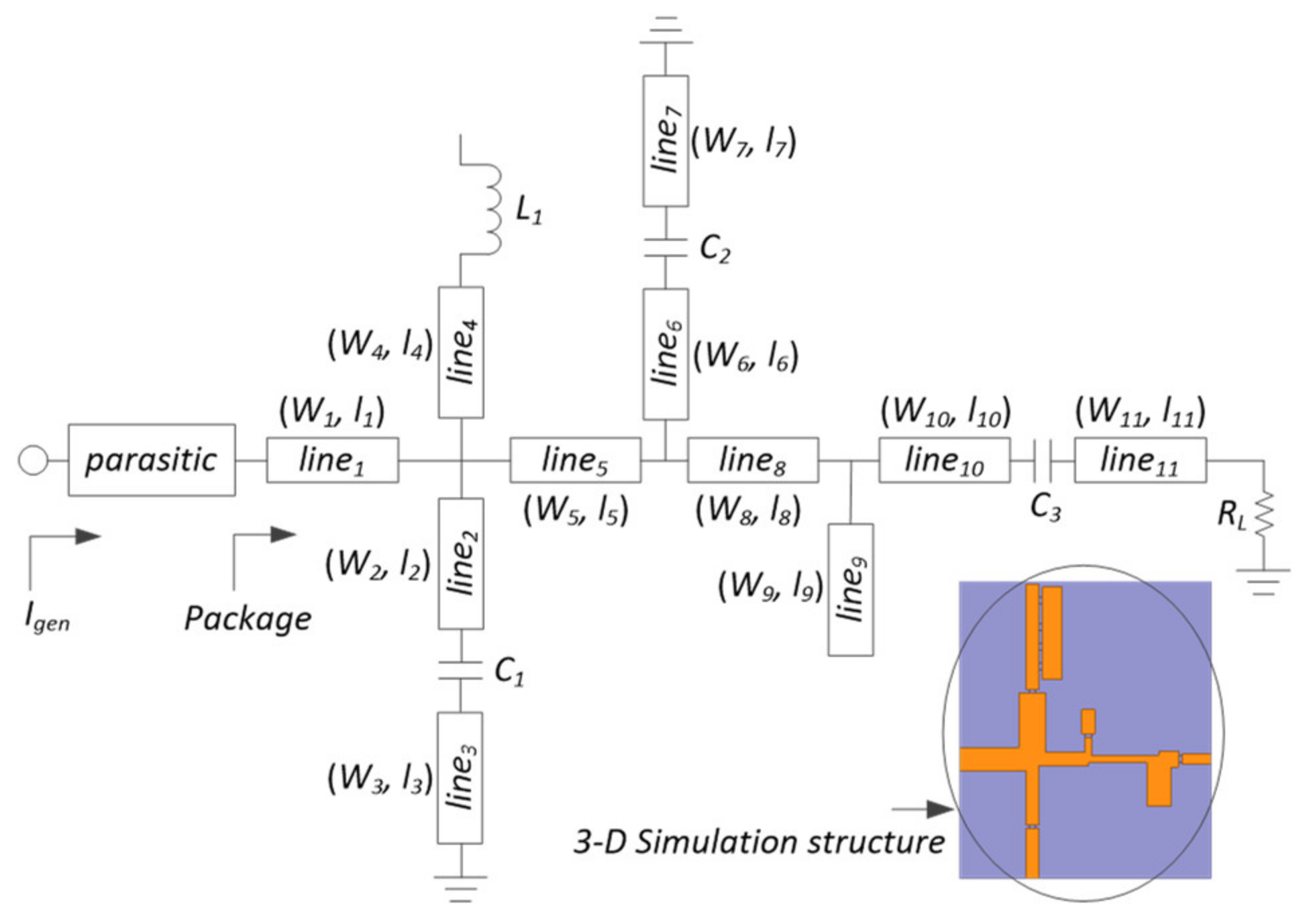A Class-F Based Power Amplifier with Optimized Efficiency in Triple-Band
Abstract
:1. Introduction
2. Design Space of Output Load Termination versus DE
3. Triple-Band Output Load Termination Design
4. Triple-Band Efficiency-Optimized PA Realization
4.1. Continuous Wave Measurement
4.2. Linearity Measurement
5. Conclusions
Author Contributions
Funding
Institutional Review Board Statement
Informed Consent Statement
Data Availability Statement
Conflicts of Interest
References
- Cripps, S. RF Power Amplifiers for Wireless Communications, 2nd ed.; Artech: London, UK, 2006. [Google Scholar]
- Tasker, P.J. Practical waveform engineering. IEEE Microw. Mag. 2009, 10, 65–76. [Google Scholar] [CrossRef]
- Nghe, C.T.; Maassen, D.; Nghiem, X.A.; Boeck, G. Ultra-wideband efficient linearized 10W GaN-HEMT power amplifier. In Proceedings of the 2017 IEEE International Symposium on Radio-Frequency Integration Technology (RFIT), Seoul, Korea, 30 August–1 September 2017; pp. 189–191. [Google Scholar] [CrossRef]
- Saxena, S.; Rawat, K.; Roblin, P. Continuous Class-B/J Power Amplifier Using a Nonlinear Embedding Technique. IEEE Trans. Circuits Syst. II Express Briefs 2017, 64, 837–841. [Google Scholar] [CrossRef]
- Zhuang, Y.; Fei, Z.; Chen, A.; Huang, Y.; Rabbi, K.; Zhou, J. Design of Multioctave High-Efficiency Power Amplifiers Using Stochastic Reduced Order Models. IEEE Trans. Microw. Theory Tech. 2018, 66, 1015–1023. [Google Scholar] [CrossRef] [Green Version]
- Jia, P.; You, F.; He, S.; Qian, X. A 0.25–1.25-GHz High-Efficiency Power Amplifier with Computer-Aided Design Based on Optimized Impedance Solution Continuum. IEEE Microw. Wirel. Compon. Lett. 2018, 28, 443–445. [Google Scholar] [CrossRef]
- Boroujeni, S.R.; Basaligheh, A.; Ituah, S.; Nezhad-Ahmadi, M.; Safavi-Naeini, S. A Broadband High-Efficiency Continuous Class-AB Power Amplifier for Millimeter-Wave 5G and SATCOM Phased-Array Transmitters. IEEE Trans. Microw. Theory Tech. 2020, 68, 3159–3171. [Google Scholar] [CrossRef]
- Quaglia, R.; Bell, J.J.; Cripps, S. New General Formulation and Experimental Verification of Harmonic Clipping Contours in High-Frequency Power Devices. IEEE Trans. Microw. Theory Tech. 2017, 65, 3903–3909. [Google Scholar] [CrossRef] [Green Version]
- Taleb-Alhagh Nia, H.; Nayyeri, V. A 0.85–5.4 GHz 25-W GaN Power Amplifier. IEEE Microw. Wirel. Compon. Lett. 2018, 28, 251–253. [Google Scholar] [CrossRef]
- Moreno Rubio, J.J.; Quaglia, R.; Baddeley, A.; Tasker, P.J.; Cripps, S.C. Design of a Broadband Power Amplifier Based on Power and Efficiency Contour Estimation. IEEE Microw. Wirel. Compon. Lett. 2020, 30, 772–774. [Google Scholar] [CrossRef]
- Qi, C.; Luo, Y.; Feng, X.; Dong, C. 1.6–2.6 GHz continuous Class-F power amplifier with gain and power-added efficiency flatness enhancement by negative feedback structure. Microw. Opt. Technol. Lett. 2019, 61, 1716–1722. [Google Scholar] [CrossRef]
- Ciccognani, W.; Colangeli, S.; Longhi, P.E.; Serino, A.; Giofré, R.; Pace, L.; Limiti, E. Broadband Amplifier Design Technique by Dissipative Matching Networks. IEEE Trans. Circuits Syst. I Regul. Pap. 2021, 68, 148–160. [Google Scholar] [CrossRef]
- Ghazizadeh, M.; Nayyeri, V. Design of a 50-W Power Amplifier with Two-Octave Bandwidth and High-Efficiency Using a Systematic Optimization Approach. IEEE Microw. Wirel. Compon. Lett. 2021, 31, 501–504. [Google Scholar] [CrossRef]
- Arnous, M.T.; Zhang, Z.; Barbin, S.E.; Boeck, G. A Novel Design Approach for Highly Efficient Multioctave Bandwidth GaN Power Amplifiers. IEEE Microw. Wirel. Compon. Lett. 2017, 27, 371–373. [Google Scholar] [CrossRef]
- De Mingo, J.; Carro, P.L.; García-Dúcar, P.; Valdovinos, A. Triple-Band Concurrent Reconfigurable Matching Network. IEEE Access 2021, 9, 96711–96721. [Google Scholar] [CrossRef]
- Lee, G.; Jung, J.; Song, J.-I. A Multiband Power Amplifier with a Reconfigurable Output-Matching Network for 10-MHz BW LTE Mobile Phone Applications. IEEE Trans. Circuits Syst. II Express Briefs 2015, 62, 558–562. [Google Scholar] [CrossRef]
- Singh, R.; Paramesh, J. A digitally-tuned triple-band transformer power combiner for CMOS power amplifiers. In Proceedings of the 2017 IEEE Radio Frequency Integrated Circuits Symposium (RFIC), Honolulu, HI, USA, 4–6 June 2017; pp. 332–335. [Google Scholar] [CrossRef]
- Cho, H.; Lee, M.; Park, C.; Park, J.Y. A Fully Integrated Switched Capacitor using Low Temperature and Wet Release Process for Reconfigurable CMOS Triple-band Power Amplifier. In Proceedings of the 2019 IEEE Asia-Pacific Microwave Conference (APMC), Singapore, 10–13 December 2019; pp. 1467–1469. [Google Scholar] [CrossRef]
- Son, H.S.; Kim, W.Y.; Jang, J.Y.; Oh, I.Y.; Park, C.S. A Triple-Band CMOS Class-E Power Amplifier for WCDMA/LTE Applications. In Proceedings of the 2013 IEEE Asia-Pacific Microwave Conference (APMC), Seoul, Korea, 5–8 November 2013; pp. 441–443. [Google Scholar] [CrossRef]
- Arabi, E.; Enrico de Falco, P.; Birchall, J.; Morris, K.A.; Beach, M. Design of a triple-band power amplifier using a genetic algorithm and the continuous mode method. In Proceedings of the 2017 IEEE Topical Conference on RF/Microwave Power Amplifiers for Radio and Wireless Applications (PAWR), Phoenix, AZ, USA, 15–18 January 2017; pp. 48–51. [Google Scholar] [CrossRef] [Green Version]







| Output Power (dBm) | DE (%) | |
|---|---|---|
| Idealized | 42 | 90.6 |
| Realistic | 41.2 | 79.2 |
| 11 mm | 3.5 mm | 10 mm | 2 mm | 6.5 mm | 2 mm | 10 mm |
| 4 mm | 8.5 mm | 2 mm | 3.3 mm | 1 mm | 3.2 mm | 2 mm |
| 10.7 mm | 1.1 mm | 7.15 mm | 3.6 mm | 2.94 mm | 2.5 mm | 6 mm |
| 1.54 mm | 15 nH | 51 pf | 51 pf | 51 pF | 50 Ohm |
| 5 mm | 1.54 mm | 5.5 mm | 4 mm | 5.75 mm | 2.9 mm | 5 mm |
| 1.5 mm | 15.85 mm | 5.4 mm | 120 nH | 51 pF | 51 pF | 10 Ohm |
| Freq. (GHz) | ACP1_L (dBc) | ACP1_H (dBc) | Pout (dBm) | Pout (W) | DE (%) |
|---|---|---|---|---|---|
| 1.52 | −26.3 | −26.1 | 35.94 | 3.93 | 40.40 |
| 2.1 | −27.3 | −27 | 35.84 | 3.84 | 42.56 |
| 2.492 | −26.5 | −26 | 35.74 | 3.75 | 36.99 |
| Ref. | Operation Bands (GHz) | DE at Operation Bands (%) | Pout (dBm) | Gain (dB) | Signal Mode |
|---|---|---|---|---|---|
| [10] | Broadband: 0.45–3.4 | 54~70.4 | >41 | 8~10.5 | CW |
| [13] | Broadband: 0.8–3.2 | 57~71 | >46.8 | 9.5~13.1 | CW |
| [18] | 0.8/1.9/2.3 | 40/45/37 | 28/29/6/26.5 | / | CW |
| [19] | 1.8/1.9/2.6 | 31/34.5/29.2 | 27.8/28.1/27.4 | / | CW |
| [20] | 0.75/1.75/2.35 | 70/60/58 | 41/40/40 | 12/11/10 | CW |
| This work | 1.52/2.1/2.492 | 63/71/59 | 41.6/41.3/40 | 11.5/12/10 | CW |
| 40.4/42.56/36.99 | 35.94/35.84/35.74 | >10 | EDGE |
Publisher’s Note: MDPI stays neutral with regard to jurisdictional claims in published maps and institutional affiliations. |
© 2022 by the authors. Licensee MDPI, Basel, Switzerland. This article is an open access article distributed under the terms and conditions of the Creative Commons Attribution (CC BY) license (https://creativecommons.org/licenses/by/4.0/).
Share and Cite
Yang, F.; Yu, H.; Li, J.; Guo, C.; Yan, S.; Chen, X.; Zhang, A.; Jin, Z. A Class-F Based Power Amplifier with Optimized Efficiency in Triple-Band. Electronics 2022, 11, 310. https://doi.org/10.3390/electronics11030310
Yang F, Yu H, Li J, Guo C, Yan S, Chen X, Zhang A, Jin Z. A Class-F Based Power Amplifier with Optimized Efficiency in Triple-Band. Electronics. 2022; 11(3):310. https://doi.org/10.3390/electronics11030310
Chicago/Turabian StyleYang, Fei, Hongxi Yu, Jun Li, Chao Guo, Sen Yan, Xiaoming Chen, Anxue Zhang, and Zhonghe Jin. 2022. "A Class-F Based Power Amplifier with Optimized Efficiency in Triple-Band" Electronics 11, no. 3: 310. https://doi.org/10.3390/electronics11030310






